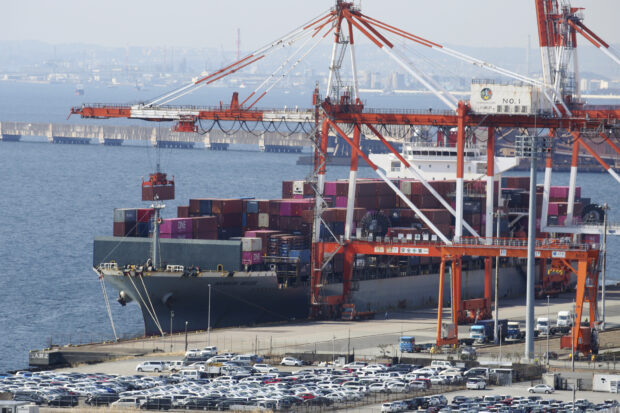Japan’s exports surged 13.5% in May, helped by cheap yen

A container ship is loaded and unloaded at a container terminal at the port of Kawasaki near Tokyo on March 9, 2022. (AP Photo/Koji Sasahara, File)
TOKYO — Japan’s exports surged 13.5 percent in May, faster than expected growth helped by a weak yen and strong demand in the U.S. and Asia.
Finance Ministry data reported Wednesday showed that the trade deficit totaled 1.22 trillion yen ($7.7 billion), down nearly 12 percent from 1.38 trillion yen a year earlier. Imports grew 9.5 percent, year-on-year, to nearly 9.5 trillion yen ($60 billion).
Exports totaled 8.3 trillion yen ($53 billion) and grew at the fastest since November 2022. Shipments to the United States were up nearly 24 percent and those to the rest of Asia rose more than 13 percent, led by double-digit growth in shipments of vehicles, electronics, and machinery.
Trade with Europe mostly fell.
The value of Japan’s imports tends to grow when the Japanese yen loses value against the U.S. dollar and other major currencies. The dollar is trading at nearly 158 yen, up from 140-yen levels a year ago.
Rising prices boost receipts
Japan is a resource-poor nation that imports almost all its oil, and higher imports of oil, gas, and other fuels are a big factor behind the deficit in May, for the second month in a row. Fruit imports also gained in May.
But a large factor behind the increases in both exports and imports was rising prices overall, which inflated their value compared with a year earlier, Marcel Thieliant of Capital Economics said in a report.
That can be seen in the muted impact of trade on the economy, which contracted at a 1.8 percent pace in the first quarter of the year.
READ: Japan’s economy shrinks, although slightly less than previously thought
In fact, “most of the increase in trade values over the past year reflects rising prices due to the sharp weakening of the yen rather than any marked improvement in volumes,” it said.
Still, trade with China, Japan’s second-largest single export market after the United States, has been reviving as its economy slowly recovers from the shocks of a meltdown in its property sector and the lingering effects of the COVID-19 pandemic.
Shipments of machinery and manufacturing components as well as vehicles showed strong growth.
Yen’s weakness
Also, the U.S. economy has remained resilient even as the Federal Reserve has kept interest rates at record levels to try to tame stubbornly high inflation.
READ: Yen falls further as Bank of Japan stands pat on rates
The yen’s weakness is the cause of some angst among Japanese policymakers. The Bank of Japan’s meeting minutes released Wednesday showed its decision-makers debating about the weak yen’s impact on inflation, which has remained relatively low compared with other major economies.
The larger fear for Japan is deflation when prices keep falling. That’s a sign of a weakening economy, and the central bank has been trying to set off a gradual rise in prices.
“But trade data today also highlighted that it is having a positive impact on exports,” Yeap Jun Rong, market analyst at IG, said in a commentary.